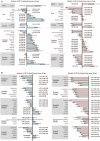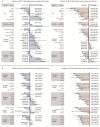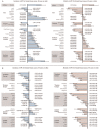Global and regional trends in incidence and mortality of female breast cancer and associated factors at national level in 2000 to 2019
- PMID: 34593698
- PMCID: PMC8850868
- DOI: 10.1097/CM9.0000000000001814
Global and regional trends in incidence and mortality of female breast cancer and associated factors at national level in 2000 to 2019
Abstract
Background: Female breast cancer (FBC) has become the most prevalent malignancy worldwide. We aimed to evaluate the global and regional burden in epidemiological trends and factors associated with the incidence and mortality of FBC.
Methods: FBC incidence and mortality in 60 selected countries by cancer registry data integrity in 2020 were estimated from the GLOBOCAN database, and their association with the human development index (HDI) was further evaluated. Trends of age-standardized rates of incidence and mortality in 60 countries from 2000 through 2019 were evaluated by joinpoint regression analysis using data of Global Burden of Disease 2019. The association between potential behavioral, metabolic, and socioeconomic risk factor exposure at the nation level retrieved from the World Bank and Global Health Observatory and the incidence and mortality of FBC were evaluated by multivariate linear regression.
Results: FBC incidence and mortality varied greatly in the 60 included countries. Higher incidence and mortality rates were typically observed in countries with higher HDIs and vice versa. During 2000 to 2019, significantly increasing trends in incidence and mortality were observed in 26 (average annual percent changes [AAPCs], 0.35-2.96) and nine countries (AAPC, 0.30-1.65), respectively, while significantly decreasing trends in both incidence and mortality were observed in 22 countries, most of which were high-HDI countries. Among the population aged ≥40 years, there were 26 and 11 countries showing significantly increased trends in incidence and mortality, respectively. Ecological analysis showed that countries with higher prevalence rates of high cholesterol and higher health expenditures were more likely to have higher FBC incidence, and countries with higher rates of obesity and poorer universal health coverage were more likely to have higher FBC mortality.
Conclusions: Despite decreased or stabilized FBC incidence and mortality rates were observed in some countries with high HDI over the past decades, disease burden became even severer in developing countries, especially for the population aged ≥40 years. Effective targeted preventive programs are strongly encouraged to reduce the FBC disease burden worldwide.
Copyright © 2021 The Chinese Medical Association, produced by Wolters Kluwer, Inc. under the CC-BY-NC-ND license.
Conflict of interest statement
None.
Figures





References
-
- Sung H, Ferlay J, Siegel RL, Laversanne M, Soerjomataram I, Jemal A, et al. . Global cancer statistics 2020: GLOBOCAN estimates of incidence and mortality worldwide for 36 cancers in 185 countries. CA Cancer J Clin 2021; 71:209–249. doi: 10.3322/caac.21660. - PubMed
-
- Porter P. “Westernizing” women's risks? Breast cancer in lower-income countries. N Engl J Med 2008; 358:213–216. doi: 10.1056/NEJMp0708307. - PubMed
-
- Collaborative Group on Hormonal Factors in Breast Cancer. Menarche, menopause, and breast cancer risk: individual participant meta-analysis, including 118,964 women with breast cancer from 117 epidemiological studies. Lancet Oncol 2012; 13:1141–1151. doi: 10.1016/s1470-2045(12)70425-4. - PMC - PubMed
MeSH terms
LinkOut - more resources
Full Text Sources
Medical
Miscellaneous

